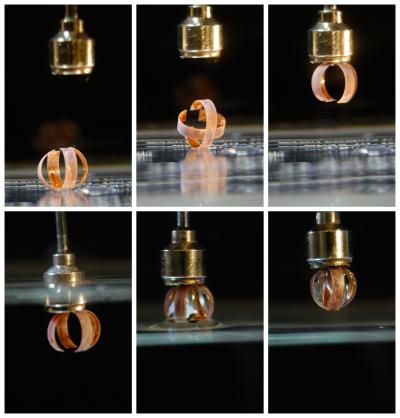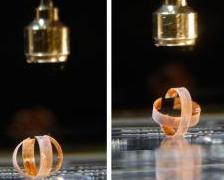[dropcap style=”font-size:100px; color:#992211;”]L[/dropcap]o-tech responses to high-tech problems are always satisfying.
Why otherwise, would that old urban myth about Soviet cosmonauts using a pencil have survived so long? (Pencils are actually no use in space, as the graphite particles caused end up clogging air filters).
Using Sellotape/Scotch Tape/Generic sticky cellulose tape to create a ‘tiny robotic claw’ for sterile scientific sampling has the same satisfying logic. A fine idea. As long as they can find the place where the roll starts.
WEST LAFAYETTE, Ind. – Scotch tape, a versatile household staple and a mainstay of holiday gift-wrapping, may have a new scientific application as a shape-changing “smart material.”
Researchers used a laser to form slender half-centimeter-long fingers out of the tape. When exposed to water, the four wispy fingers morph into a tiny robotic claw that captures water droplets.
The innovation could be used to collect water samples for environmental testing, said Babak Ziaie, a Purdue University professor of electrical and computer engineering and biomedical engineering.
The Scotch tape – made from a cellulose-acetate sheet and an adhesive – is uniquely suited for the purpose.
“It can be micromachined into different shapes and works as an inexpensive smart material that interacts with its environment to perform specific functions,” he said.
Doctoral student Manuel Ochoa came up with the idea. While using tape to collect pollen, he noticed that it curled when exposed to humidity. The cellulose-acetate absorbs water, but the adhesive film repels water.
“So, when one side absorbs water it expands, the other side stays the same, causing it to curl,” Ziaie said.
 The graspers were coated with magnetic particles, which could allow researchers to retrieve the devices in the field by using a magnet. (Manuel Ochoa, Purdue University)
The graspers were coated with magnetic particles, which could allow researchers to retrieve the devices in the field by using a magnet. (Manuel Ochoa, Purdue University)
A laser was used to machine the tape to a tenth of its original thickness, enhancing this curling action. The researchers coated the graspers with magnetic nanoparticles so that they could be collected with a magnet.
“Say you were sampling for certain bacteria in water,” Ziaie said. “You could drop a bunch of these and then come the next day and collect them.”

The aim of art is to represent not the outward appearance of things, but their inward significance. – Aristotle




















